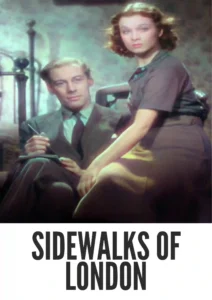Video Sources 0 Views

Synopsis
Busking, Ballet, and Big Dreams: Sidewalks of London (1938) in Dazzling Color

Step back in time to the enchanting streets of London with Sidewalks of London, a delightful musical comedy from 1938, now beautifully colorized for a viewing experience like never before. Also known as St. Martin’s Lane, this film offers a heartwarming blend of music, dance, and drama set against the backdrop of pre-war London. Perfect for fans of classic musicals and those who appreciate a touch of nostalgia, this HD download brings a timeless tale of love and ambition to your screen.
Sidewalks of London Storyline: A Street Performer’s Journey
Sidewalks of London tells the story of Charles Staggers (Charles Laughton), a charismatic street performer who captivates audiences with his lively routines. One fateful night, he encounters a young runaway named Liberty (Vivien Leigh) and takes her under his wing, teaching her the tricks of the trade.As Liberty blossoms into a talented performer, she attracts the attention of a composer who offers her a chance to star in a ballet. Torn between her loyalty to Charles and her ambition for a better life, Liberty embarks on a journey of self-discovery and romance. Amidst the glitz and glamour of the London stage, she finds herself caught between two worlds. Sidewalks of London is a heartwarming tale of love, ambition, and the enduring power of dreams.
Movie Cast
The film boasts a stellar cast of actors who bring this charming story to life:
- Charles Laughton as Charles Staggers
- Vivien Leigh as Liberty
- Rex Harrison as Harley Street
- Larry Adler as Larry
- Tyrone Guthrie as The First Production Manager
Movie Genre
Sidewalks of London falls into the genre of musical comedy, with elements of drama and romance that are characteristic of British cinema in the late 1930s. Its vibrant musical numbers and heartfelt storyline make it a captivating and uplifting film.
Historical Context: Pre-War Britain and Cinematic Escapism
Released in 1938, Sidewalks of London offers a glimpse into the cultural landscape of pre-war Britain, showcasing the vibrant street life and burgeoning entertainment industry of the era. The film provided audiences with a welcome escape from the anxieties of the time. While Sidewalks of London may not be as widely celebrated as some of its contemporaries, it remains a valuable cultural artifact that reflects the spirit of a bygone era.
Colorization Details
This colorized version of Sidewalks of London has been meticulously restored using modern digital techniques, enhancing the visual appeal while preserving the film’s original charm. The colorization process involved carefully analyzing the grayscale tones of the original black and white footage and assigning appropriate colors to each scene. While the specific software used remains proprietary, the techniques employed included advanced algorithms for color palette selection and image enhancement. This painstaking process breathes new life into the characters and settings, making the story even more enchanting for modern audiences.
Technical Details
- Director: Tim Whelan
- Screenplay: Clemence Dane, Sergei Nolbandov, A. de Grunwald
- Story: Clemence Dane
- Cinematography: Jules Kruger
- Edited by: Hugh Stewart
- Production Company: Mayflower Pictures
- Distributed by: Paramount British Pictures
- Runtime: 85 minutes
Technical Specifications
- Download Format: MP4
- Resolution: HD (1080p)
- Compatibility: Compatible with most devices, including smartphones, tablets, computers, and smart TVs.
Reviews and Critical Reception
Sidewalks of London (1938) is celebrated for its charming story, memorable performances, and vibrant depiction of London street life. As a heartwarming and entertaining film, Sidewalks of London provides a unique perspective on the cultural landscape of pre-war Britain.
FAQs
- Q: What is Sidewalks of London about?
- A: Sidewalks of London is a musical comedy about a street performer who takes a young runaway under his wing.
- Q: Is Sidewalks of London (1938) a well-known British film?
- A: Sidewalks of London is a beloved classic that offers a glimpse into the entertainment industry of pre-war Britain.
- Q: Is this version of Sidewalks of London colorized?
- A: Yes, this version has been professionally colorized to enhance the viewing experience.
- Q: What makes Sidewalks of London interesting for classic film fans?
- A: Sidewalks of London offers valuable insights into the cultural landscape of pre-war Britain, showcasing its vibrant street life and burgeoning entertainment industry.
- Q: What is the download format?
- A: The download format is MP4, which is compatible with most devices.
- Q: What resolution is the download?
- A: The resolution is HD (1080p), providing a high-quality viewing experience.
Download Now in HD!
Watch Sidewalks of London Today!










